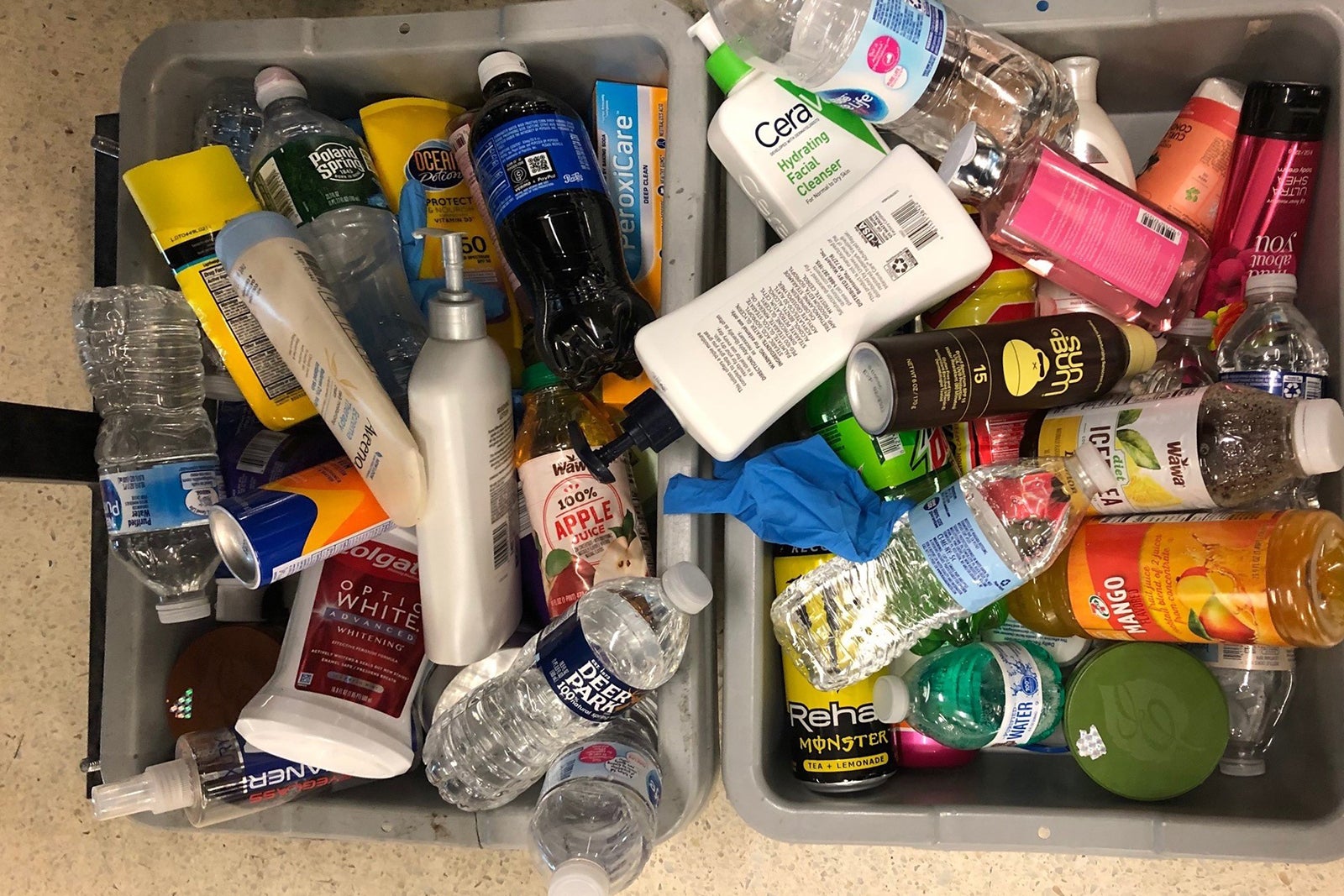Editor’s note: This story is continually updated.
Nothing starts your trip off on the wrong foot like a long security line at the airport. Though there are tools to shorten your time waiting in line — namely, TSA PreCheck and Clear — your experience, unfortunately, depends on your fellow travelers to a certain degree. People in front of you might be moving slowly because they forgot to take their keys out of their pockets or because they’re new to TSA PreCheck and didn’t realize they could keep their shoes on.
Nonetheless, one consistent factor slowing down airport security lines is travelers attempting to bring items the Transportation Security Administration prohibits onto aircraft. Not only are prohibited items flagged during security, but the staff calls the police and searches your items. Affected travelers may even face arrest and a fine, slowing down everything overall.
TPG recently spoke to a TSA agent at Baltimore/Washington International Thurgood Marshall Airport (BWI) about some of the most commonly confiscated items the TSA collects from travelers attempting to carry them through security at airports.
Agents most often see travelers bringing full-size liquids and knives, both of which are prohibited.
If you plan on traveling with any of the below items, remember to check them.
Guns
This seems like a no-brainer, yet many people seem to forget it, according to TSA Northeast spokesperson Lisa Farbstein, who frequently documents TSA-confiscated guns at airports on X, formerly known as Twitter.
Guns are not prohibited on aircraft when they’re unloaded, but a large majority of the illegal finds from the TSA’s X feed involve illicit firearms.
TSA officers intercepted 1,508 firearms at airport security checkpoints during the first quarter of 2023 for an average of 16.8 firearms per day, per TSA data. More than 93% of those were loaded.
“When passengers bring firearms to the TSA security checkpoint, TSA suspends their TSA PreCheck® eligibility for five years, which includes current TSA PreCheck members. Additionally, TSA may conduct additional screening for those passengers to ensure no other threats are present,” the TSA said in a press statement April 20. “Late last year, TSA increased the maximum civil penalty for a firearms violation to $14,950. Passengers with firearms found in a carry-on bag at a TSA checkpoint are also subject to applicable city or state laws at that airport that may include citation or arrest.”
As a reminder, firearms must be unloaded and checked in a locked, hard-sided container and declared to the airline at check-in. Similarly, ammunition (from single bullets to boxes full of bullets), gun magazines (empty or ones with bullets), pepper spray, tasers/stun guns, sparklers and fireworks (and anything else labeled as flammable), and replica weapons are also prohibited in carry-on bags.
You can bring these items in your checked luggage if they are properly packed. Ammunition must be securely packed in fiber, wood or metal boxes, or another packaging specifically designed to carry small amounts of ammunition.
While toy guns are “generally permitted,” the TSA recommends travelers pack them in checked baggage. Items that look like real firearms — like Nerf guns — are prohibited.
Full-size hygiene products

Liquids, specifically those exceeding 3.4 ounces, are the most common items confiscated from carry-on bags, per TSA.
As a reminder, liquids, gels, aerosols and spreadables larger than 3.4 ounces cannot be carried on per TSA’s 3-1-1 liquid rule.
“Basically, if you can spill it, spray it, spread it, pump it or pour it, and it’s larger than 3.4 ounces, then it should not be packed in a carry-on bag,” Farbstein said.
This rule means you can carry liquids, gels and aerosols in travel-size containers onto a plane as long as they’re no more than 3.4 ounces (100 milliliters) and can all fit in a single 1-quart, resealable bag.
“Similar items, yet not toiletries, are food items that are liquid or spreadable such as apple sauce, jams/jellies/preserves, canned vegetables with liquid inside the cans, Nutella and peanut butter,” Farbstein said. These must also adhere to the 3-1-1 liquid rule. Note this also applies to frozen and steamed items, which are also considered liquids.
Common examples of prohibited liquids include beverages (such as water bottles, energy drinks, juice, soda and alcohol), hair gel, aftershave, cologne, perfume, shampoo, conditioner, Vaseline, toothpaste and sunblock.
Note that the TSA makes exemptions for medically necessary liquids, medications and creams of more than 3.4 ounces or 100 milliliters in your carry-on bag.
The pandemic-induced rule allowing hand sanitizer over 3.4 ounces is no longer in place, so that must also be travel size.
Alcohol
You might not realize that you can actually bring your own alcohol on a flight — but with several limitations. Beverages with more than 24% but not more than 70% alcohol can be brought in checked bags; each passenger can bring no more than 5 liters (1.3 gallons) of alcohol, and it must remain unopened in its original retail packaging, according to the TSA. You can bring miniature bottles of alcohol in your carry-on but they must be able to comfortably fit in a single quart-size bag.
However, federal law prohibits travelers from consuming their own alcohol on board — a flight attendant must serve the alcohol.
The Federal Aviation Administration fined a handful of passengers more than $1 million in 2021 for bringing their own alcohol on board, getting drunk and ignoring flight attendants’ instructions.
Fertilizer
If you have a green thumb, I’m sorry to inform you that fertilizer is not allowed in carry-on or checked luggage as it can be flammable. However, you can bring plants (and planting seeds) if your plants fit in the overhead bin or underneath your seat.
Miscellaneous items
Another category of items prohibited on board are tools exceeding 7 inches. That’s because these items could be considered bludgeoning weapons. Examples include hammers, wrenches, pliers, screwdrivers, saws and drills.
Additionally, no knives or blades of any size are allowed, including but not limited to butter knives, hunting knives, credit card knives, keychain knives, Swiss Army knives, tactical fighting knives and cake knives. This also includes mini blenders, which can’t go through security because of the blade.
If you travel with a razor, the blade must come out, except for plastic handle razors, which can be carried on as is. Single-edged blades must be checked and emptied when the bag comes through security, per the TSA.
Other items, such as torch lighters and pepper spray, cannot be carried on either.
What happens to these confiscated items?
You may be wondering what the TSA does with all these items once they’re confiscated.
Water, for example, is thrown away, while most of the other items are collected on a monthly basis in conjunction with the airport’s state.
Firearms are confiscated by police, and these travelers are subject to a fine and legal action based on local jurisdiction laws.
Though most passengers are willing to just part ways with their confiscated items, the TSA offers the option to ship your items back to you based on U.S. Postal Service and shipper requirements of that particular location.
Most airports have a mailing station near the metal detectors where you can pay to ship items back to you, so be sure to inquire with TSA if your items are important to you.
Bottom line
If you are unsure if an item can be packed in a carry-on bag or a checked bag, download the MyTSA app and use its “What can I bring?” feature to double-check the item.
Travelers can also send a question by texting “Travel” to AskTSA (275-872). For a full list of acceptable TSA items, visit this page.
Related reading:
- 12 key things to know about TSA PreCheck
- Why you should get TSA PreCheck and Clear — and how you can save on both
- 7 ways to get free or discounted TSA PreCheck, Global Entry and Clear
- 15 easy, breezy, beautiful TSA-approved health and beauty items
- 5 clear toiletry bags for travel that are TSA compliant
- TSA rolls back plan to require more Clear users to show ID
- TSA announces Telos as latest TSA PreCheck enrollment provider




